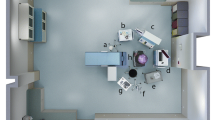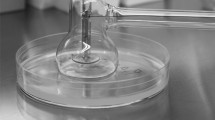Abstract
Atmospheric low-temperature plasma has received attention for application in disinfection methods. In this study, we develop a plasma bubbling method as a disinfection method. In the plasma bubbling method, the bactericidal effect can be introduced into the water by bubbling with carbon dioxide plasma. The plasma bubbling method is effective for the treatment of Staphylococcus aureus, Pseudomonas aeruginosa, Candida albicans, Serratia marcescens, and Fusarium solani, which pose problems in the field of ophthalmology. In addition, we develop ultrasonic-combined plasma bubbling, in which plasma bubbling imposes a bactericidal effect, whereas ultrasonic exerts a detachment effect as a disinfection method for adherent bacteria on medical equipment. Ultrasonic-combined plasma bubbling demonstrates a prominent bactericidal effect on P. aeruginosa adherent bacteria on stainless steel plates and can be used to the measuring prism (MP) of applanation tonometers. In observation the MP treated with plasma bubbling and ultrasonic-combined plasma bubbling for 11 h, no damage to the MPs was observed.




Similar content being viewed by others
Data Availability
Not applicable.
Code Availability
Not applicable.
References
Shintani H (2017) Ethylene oxide gas sterilization of medical devices. Biocontrol Sci 22:1–16. https://doi.org/10.4265/bio.22.1
FernandesOYong PK, Terashita D (2020) Understanding infection prevention practices in optometry clinics. Optom Vis Sci 97:24–27. https://doi.org/10.1097/OPX.0000000000001464
Domonkos M, Tichá P, Trejbal J, Demo P (2021) Applications of cold atmospheric pressure plasma technology in medicine, agriculture and food industry. Appl Sci 11:4809. https://doi.org/10.3390/app11114809
Bekeschus S, Favia P, Robert E, von Woedtke T (2019) White paper on plasma for medicine and hygiene: future in plasma health sciences. Plasma Processes Polym 16:1800033. https://doi.org/10.1002/ppap.201800033
Ben Belgacem Z, Carré G, Charpentier E et al (2017) Innovative non-thermal plasma disinfection process inside sealed bags: assessment of bactericidal and sporicidal effectiveness in regard to current sterilization norms. PLoS ONE 12:1–18. https://doi.org/10.1371/journal.pone.0180183
Maho T, Binois R, Brulé F et al (2021) Anti-bacterial action of plasma multi-jets in the context of chronic wound healing. Appl Sci 11:9598. https://doi.org/10.3390/app11209598
Ehlbeck J, Schnabel U, Polak M et al (2010) Low temperature atmospheric pressure plasma sources for microbial decontamination. J Phys D Appl Phys 44:013002. https://doi.org/10.1088/0022-3727/44/1/013002
Kurosawa M, Takamatsu T, Kawano H, Hayashi Y, Miyahara H, Ota S, Okino A, Yoshida M (2019) Endoscopic hemostasis in porcine gastrointestinal tract using CO2 low-temperature plasma jet. J Surg Res 234:334–342. https://doi.org/10.1016/j.jss.2018.09.068
Yanagawa Y, Kawano H, Kobayashi T, Miyahara H, Okino A, Mitsuhara I (2017) Direct protein introduction into plant cells using a multi-gas plasma jet. PLoS ONE 12:e0171942. https://doi.org/10.1371/journal.pone.0171942
Miyahara H, Shibata M, Oshita T, Takamatsu T, Okino A (2013) Hydrophilization of polyimide film using damage-free multi-gas plasma jet. Kagaku Kogaku Ronbunshu 39:372–377. https://doi.org/10.1252/kakoronbunshu.39.372
Lee K, Park BJ, Lee DH, Lee I-S, Hyun SO, Chung K, Park C (2005) Sterilization of Escherichia coli and MRSA using microwave-induced argon plasma at atmospheric pressure. Surf Coat Technol 193:35–38. https://doi.org/10.1016/j.surfcoat.2004.07.034
Maisch T, Shimizu T, Li YF, Heinlin J, Karrer S, Morfill G, Zimmermann JL (2012) Decolonisation of MRSA, S. aureus and E. coli by cold-atmospheric plasma using a porcine skin model in vitro. PLoS ONE 7:e34610. https://doi.org/10.1371/journal.pone.0034610
Takamatsu T, Uehara K, Sasaki Y, Hidekazu M, Matsumura Y, Iwasawa A, Ito N, Kohno M, Azuma T, Okino A (2015) Microbial inactivation in the liquid phase induced by multigas plasma jet. PLoS ONE. https://doi.org/10.1371/journal.pone.0132381
Kawano H, Takamatsu T, Matsumura Y, Miyahara H, Iwasawa A, Okino A (2018) Influence of gas temperature in atmospheric non-equilibrium plasma on bactericidal effect. Biocontrol Sci 23:167–175. https://doi.org/10.4265/bio.23.167
Suenaga Y, Takamatsu T, Aizawa T et al (2021) Influence of controlling plasma gas species and temperature on reactive species and bactericidal effect of the plasma. Appl Sci 11:11674. https://doi.org/10.3390/app112411674
Saito Y, Uraoka T, Matsuda T et al (2007) A pilot study to assess the safety and efficacy of carbon dioxide insufflation during colorectal endoscopic submucosal dissection with the patient under conscious sedation. Gastrointest Endosc 65:537–542. https://doi.org/10.1016/j.gie.2006.11.002
Hussein AMJ, Bartram CI, Williams CB (1984) Carbon dioxide insufflation for more comfortable colonoscopy. Gastrointest Endosc 30:68–70. https://doi.org/10.1016/S0016-5107(84)72319-4
Joaquin JC, Kwan C, Abramzon N, Vandervoort K, Brelles-Mariño G (2009) Is gas-discharge plasma a new solution to the old problem of biofilm inactivation? Microbiology (Reading) 155:724–732. https://doi.org/10.1099/mic.0.021501-0
Smet C, Govaert M, Kyrylenko A, Easdani M, Walsh JL, Van Impe JF (2019) Inactivation of single strains of Listeria monocytogenes and Salmonella typhimurium planktonic cells biofilms with plasma activated liquids. Front Microbiol 10:1539. https://doi.org/10.3389/fmicb.2019.01539
Kamgang-Youbi G, Herry JM, Brisset JL, Bellon-Fontaine MN, Doubla A, Naïtali M (2008) Impact on disinfection efficiency of cell load and of planktonic/adherent/detached state: case of Hafnia alvei inactivation by plasma activated water. Appl Microbiol Biotechnol 81:449–457. https://doi.org/10.1007/s00253-008-1641-9
Junk AK, Chen PP, Lin SC, Nouri-Mahdavi K, Radhakrishnan S, Singh K, Chen TC (2017) Disinfection of tonometers: a report by the American Academy of Ophthalmology. Ophthalmology 124:1867–1875. https://doi.org/10.1016/j.ophtha.2017.05.033
Ragan A, Cote SL, Huang JT (2018) Disinfection of the Goldman applanation tonometer: a systematic review. Can J Ophthalmol 53:252–259. https://doi.org/10.1016/j.jcjo.2017.09.013
Guo J, Huang K, Wang J (2015) Bactericidal effect of various non-thermal plasma agents and the influence of experimental conditions in microbial inactivation: a review. Food Control 50:482–490. https://doi.org/10.1016/j.foodcont.2014.09.037
Acknowledgements
This study was based on the Cooperative Research Project of the Research Center for Biomedical Engineering and was supported by JSPS KAKENHI Grant Number [20K07039]. This research is based on the Cooperative Research Project of Research Center for Biomedical Engineering.
Author information
Authors and Affiliations
Contributions
All authors contributed to the study conception and design. Productions of Plasma bubbling device were performed by AO, YS, HK. Material preparations were performed by NI. Developments of methodology were performed by YM, NI, AI. Data collections and analyses were performed by YS, HK, TT, YM, NI, AI, AO. The first draft of the manuscript was written by YS and all authors commented on previous versions of the manuscript. All authors read and approved the final manuscript.
Corresponding author
Ethics declarations
Conflict of interest
The authors have no conflicts of interest.
Ethical Approval
Not applicable.
Consent to Participate
The authors have consented to be participated in this study.
Consent for Publication
The authors have consented to be published in Current Microbiology.
Additional information
Publisher's Note
Springer Nature remains neutral with regard to jurisdictional claims in published maps and institutional affiliations.
Supplementary Information
Below is the link to the electronic supplementary material.
Rights and permissions
About this article
Cite this article
Suenaga, Y., Kawano, H., Takamatsu, T. et al. Ultrasonic-Combined Plasma Bubbling for Adherent Bacteria Disinfection on Medical Equipment. Plasma Chem Plasma Process 42, 575–586 (2022). https://doi.org/10.1007/s11090-022-10241-7
Received:
Accepted:
Published:
Issue Date:
DOI: https://doi.org/10.1007/s11090-022-10241-7




